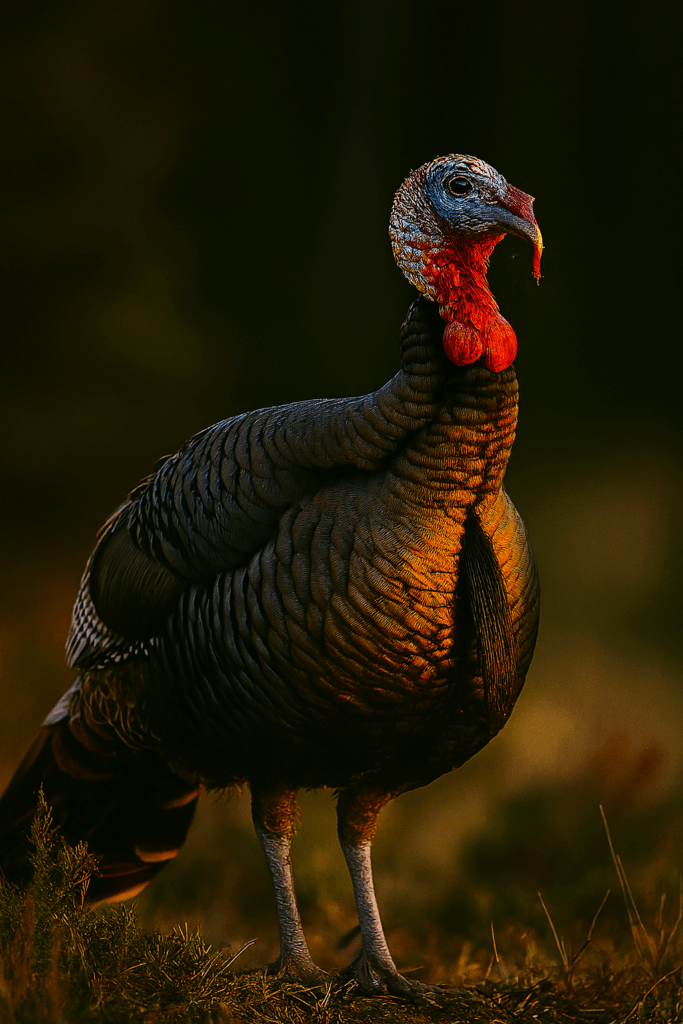Wild Turkey DIY Hunting Guide and Tips (2025)
Wild turkey hunting guide advice is essential for any DIY hunter determined to succeed on public land. Wild turkeys are wily birds that reward patient hunters who learn their calls, patterns, and preferred hangouts. Master the stratagems below to outsmart toms without ever needing to pay for an outfitter.
The Wild Turkey Grand Slam
Achieving a turkey Grand Slam is the ultimate goal for many wild turkey hunters. The Grand Slam challenges hunters to harvest all four primary subspecies of wild turkeys found across the United States: Eastern, Osceola, Merriam’s, and Rio Grande. Tracking your progress makes the journey even more rewarding and organized. Use the Grand Slam Tracker at turkeyandelk.com to log your hunts and celebrate each milestone as you work toward this prestigious hunting accomplishment.

Species Classification
Wild turkeys (Meleagris gallopavo) belong to the Phasianidae family alongside pheasants and grouse. Originating in North America, they split into five subspecies, with Eastern and Rio Grande being the most common. Only males—toms—display the flamboyant fan tails and wattles; hens fly under the radar with muted plumage and smaller size.
Physical Description
Adult toms weigh up to 24 pounds and stretch three to four feet in length. Their iridescent body feathers shimmer bronze and copper in sunlight. The bare head shifts from blue to red during the rut, while a fleshy beard drops from their chest. Hens weigh closer to 10 pounds and carry subdued brown feathers for camouflage, making them harder to spot in scrub and brush.
Distribution and Habitat
Wild turkeys occupy oak woodlands, riparian corridors, pine-hardwood mixes, and even desert grasslands. They roost in tall trees at night but forage on the forest edges and clearings by day. On public land, zero in on field edges bordering hardwood ridges, seasonal creeks, and logging cuts—they’ll gobble up nuts, berries, and insects in these rich buffers.
Season Dates and Regulations
Spring turkey seasons kick off in April or May and run through May or early June, varying by state and zone. Many jurisdictions split seasons into youth, general, and special permit hunts. Fall seasons often run from September through November. Bag limits usually cap at one or two turkeys per hunter. Always confirm exact dates, permit availability, and tag-reporting rules with your state wildlife agency before heading out.
Best Hunting Regions
The Southeast—Georgia, Alabama, and South Carolina—boasts booming turkey numbers and long spring seasons. The Ozarks of Missouri and Arkansas offer public forests teeming with birds. In the West, Texas hill country and Arizona’s ponderosa pine zones hold healthy Rio Grande and Merriam’s flocks. Each region demands different tactics; learn the local turkey vernacular and adapt.
Hunting Equipment: Gun and Ammo
A 12-gauge shotgun with a modified or improved cylinder choke and No. 4 or 5 lead shot is standard for spring gobblers inside 40 yards. If you’re hauling heat into the field, gear gloves, facemask, and a comfortable shotgun sling. For bowhunters, a 50–60 pound draw weight and expandable mechanical broadheads with at least 1¼-inch cutting diameter deliver clean kills through the cranial shot.
Hunting Methods and Techniques
Spring turkey hunts hinge on calling finesse and concealment. Setup in a low-profile ground blind or bust out a layout blind near a strut zone. Start before first light and use soft yelps, clucks, and purrs to pull hens, then switch to loud gobble imitations or a slate turkey call to tempt jakes and toms. In fall, spot-and-stalk tactics work as birds feed in open fields. Move slowly, use natural cover, and keep calls to a whisper.
Licenses and Tags
A valid hunting license plus a turkey-specific permit or tag is mandatory in every state. Many areas require a spring permit separate from the fall tag. Some premium zones sell limited-entry tags via lottery—if you strike out, focus on general-season public lands. Don’t forget any mandatory hunter education credentials and always fill out your tag immediately after the harvest.
Diet and Feeding
Turkeys forage widely, consuming acorns, beech nuts, berries, grass seeds, and insects. In spring, tender shoots and caterpillars fuel their energy for breeding. Late summer brings grasshoppers and tomatoes, while fall relies on hard mast like acorns and hickory nuts. Scouting feeding flats and logging-road edges teeming with insects can pinpoint flocks before daylight.
Reproduction and Life Cycle
The turkey rut peaks in spring when gobblers display strutting behavior and hens nest. Hens lay 10–12 eggs in shallow ground nests concealed in brush, incubating for 26–28 days. Poults hatch in late May or early June and fledge by eight weeks. Juveniles disperse widely, often following hens until the next breeding season offers solo opportunities to intercept sub-adult jakes.
Population Status
Conservation efforts since the 1950s have restored turkey populations from near extirpation in many states. Today, wildlife agencies monitor flocks through spring gobbler counts, brood surveys, and hunter-harvest data to set sustainable seasons. While overall numbers remain strong, drought, predation, and habitat loss can cause localized dips, so scout current agency reports before predicting bird density.
Meat Quality and Processing
Wild turkey breast meat is lean and mild when field-dressed promptly. Pluck the bird in the field and cool it as quickly as possible by removing entrails and wrapping in game bags. Aging in a cooler for 24 hours can improve flavor and tenderness. Smoke legs and thighs for deli-style sandwich meats, roast breasts whole for moist long-grain rice dishes, or grind dark meat into sausage for rich breakfast staples.
Safety Considerations
Treat every shotgun as loaded and practice safe muzzle control, especially when shooting into cover. Wear hunter orange if required during fall hunts, and always communicate with hunting partners about stand or blind locations. Carry a small first-aid kit, a whistle, and a GPS or compass. Never climb trees after shooting until you’re certain the bird is down and clear of other hunters.
Tracks and Sign
Turkey tracks show three forward-pointing toes and a shorter hind toe, each toe connecting at a rough triangular pad. Look for scratching patterns where birds have spun in grass or leaf litter chasing insects. Scrapes—shallow pits created by toms drumming their wings—often appear under low tree limbs or along fence rows. Fresh droppings resemble twisted ropes, marking regular loafing areas.
Similar Species
The ocellated turkey of Central America occasionally escapes game farms, but real confusion comes from domestic turkeys or half-domestic crosses near farmsteads. Wild adults have narrow wing and tail feathers with crisp barring, while domestics present floppy, white or buff plumage and rounded tails. Stay out of agricultural zones to avoid hybrids and ensure a legal harvest of pure wild birds.
Step into that blind or stalk those fields with confidence. Read every gobble, every scratch, and every swirl of feathers on public land—and own the spring hunt like the DIY badass you are.
